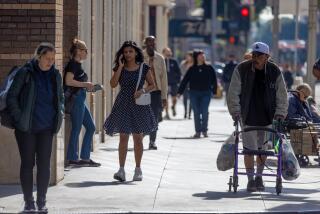Rise in Immigrants, Drop in Car-Poolers : Census: The 1990 survey shows a jump in foreign-born residents. Also, the â80s saw more people driving to work alone.
WASHINGTON â New Census Bureau figures show that the foreign-born population of the United States rose dramatically in the 1980s to about 7.9% of all residents, and most of these immigrants are centered in urban areas, where they pose potentially grave problems for educators.
The statistics show a pronounced move to a multicultural society over the past 10 years, from a point in 1980 when foreign-born residents accounted for only 6.2% of the population. And over the past 25 years, demographers say, the trend in immigration has shifted away from Europeans to people of Latino and Asian ancestry.
The new Census Bureau figures, compiled in the spring of 1990, were derived from a survey taken every 10 years that produces a range of information about the characteristics, habits and lifestyles of Americans.
This survey of 17.7 million homes also showed, for example, that nearly three-quarters of American commuters drove to work alone in 1990, rejecting car pools and mass transit. The figures revealed that nearly 60% of mothers with children younger than 6 were in the labor force, an increase from 45.7% a decade earlier. And only 4.8% of American households were without telephones, down from 7.1% in 1980.
Across the nation, 19.7 million residents in 1990 were foreign-born, the latest statistics show. Almost 32 million people speak foreign languages at home, with more than 40% of those reporting that they âdo not speak English very well.â The rise in households where foreign languages are spoken amounted to almost 3% over the last 10 years.
Peter Morrison, a demographer at the RAND Corp., a Santa Monica think tank, said the influx of immigrants means that schools in Los Angeles County and other urban centers, where most foreign-born residents have settled, face the daunting task of training many non-English speakers for employment and contributing roles in society.
âThe changing role for the education system is a serious problem,â Morrison said.
Shifting patterns of immigration showed the number of immigrants from Mexico, for example, more than doubled to 4.4 million over the decade. A parallel steep increase was reflected in the new total of 5.4 million immigrants from Asia.
While most of these new arrivals found homes in such cities as Los Angeles, Chicago, Washington and Miami, there was scant impact in the Midwest, where less than 4% of all residents are foreign-born.
Figures for the Census Bureauâs Pacific Division, including California, Washington, Oregon, Hawaii and Alaska, showed the foreign-born population was 7.1 million in 1990, with almost half entering the United States during the previous decade.
About 5.7 million in the region spoke Spanish at home, and 2.3 million spoke an Asian or Pacific Island language.
The rise in one-in-a-car commuters, up to 73.2% from 64.4% in 1980, and the accompanying decline in car-pooling (now 13.4% of drivers) and mass transit use (now only 5.3% of commuters) was not unexpected, authorities said. They attributed the shifting patterns to companies moving to less centralized locations, drops in gasoline prices, cuts in federal transit subsidies and an increase in working couples.
Said Mark Wright of the Assn. for Commuter Transportation:
âItâs easier to match people up for car pools if theyâre going to predictable places at predictable times. But as people move to find affordable housing while their workplaces move to the suburbs, they may find it more difficult to car-pool.â
Chip Bishop of the American Public Transit Assn. said âthe 1980s were not kind years to public transit,â explaining that there was a 50% cutback, after inflation, in federal aid for construction and operation of mass transit systems from 1980 to 1990.
However, Wright and Bishop said the outlook was bright for the car pools and mass transit. They credited adoption of the Clean Air Act of 1990 and the Intermodal Surface Transportation Efficiency Act last year, which, according to Bishop, âshifted the focus away from road building toward ride-sharing.â
There was less encouraging news, however, for the economic well-being of families.
About 42% of households lived on incomes below $25,000, up from 31% a decade earlier. As poverty rates grew, housing costs shot up. According to the census, median mortgage costs rose 27% in 10 years to $737 a month. Median rents rose 16% to $581.
As a whole, the nationâs education level rose during the 1980s. Persons holding a high school degree increased from two-thirds to three-quarters of the population. Those with a bachelorâs degree rose to 20% from 16%.
The census found that the number of people reporting disabilities grew about 500,000, from 12.3 million to 12.8 million over the 10-year period. Of this number, 39% were in the labor force and the remainder said they were prevented from working.
More to Read
Sign up for Essential California
The most important California stories and recommendations in your inbox every morning.
You may occasionally receive promotional content from the Los Angeles Times.





![[20060326 (LA/A20) -- STATING THE CASE: Marchers organized by unions, religious organizations and immigrants rights groups carry signs and chant in downtown L.A. "People are really upset that all the work they do, everything that they give to this nation, is ignored," said Angelica Salas of the Coalition of Humane Immigrant Rights. -- PHOTOGRAPHER: Photographs by Gina Ferazzi The Los Angeles Times] *** [Ferazzi, Gina -- - 109170.ME.0325.rights.12.GMF- Gina Ferazzi/Los Angeles Times - Thousands of protesters march to city hall in downtown Los Angeles Saturday, March 25, 2006. They are protesting against House-passed HR 4437, an anti-immigration bill that opponents say will criminalize millions of immigrant families and anyone who comes into contact with them.]](https://ca-times.brightspotcdn.com/dims4/default/34f403d/2147483647/strip/true/crop/1983x1322+109+0/resize/840x560!/quality/75/?url=https%3A%2F%2Fcalifornia-times-brightspot.s3.amazonaws.com%2Fzbk%2Fdamlat_images%2FLA%2FLA_PHOTO_ARCHIVE%2FSDOCS%2854%29%2Fkx3lslnc.JPG)




